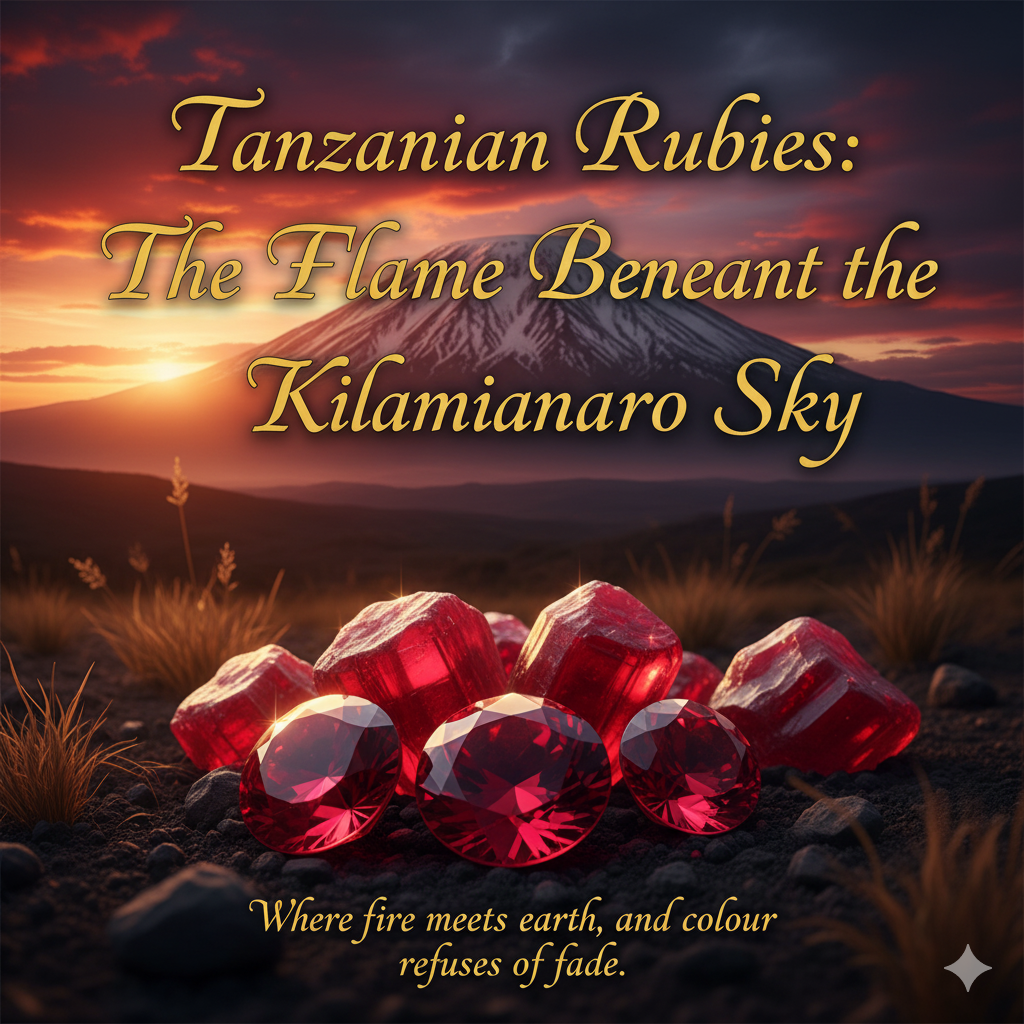Tanzanian Rubies: The Flame Beneath the Kilimanjaro Sky
Where fire meets earth, and colour refuses to fade.
1. A Continent’s Red Heart
In the foothills of Mount Kilimanjaro, where the African plains shimmer in heat and dust, the earth occasionally breaks its silence — and releases flame.
That flame is ruby.
Tanzania, known for its tanzanite and sapphires, is also home to some of the world’s most compelling rubies — stones that burn not with refinement, but with life.
They carry the raw pulse of the continent itself: deep, resonant, unfiltered.
If Burmese rubies are the poetry of elegance, Tanzanian rubies are the poetry of survival.
2. The Geography of Fire
Tanzania’s rubies are scattered across three main regions — each with its own signature hue and story:
| Region | Key Locality | Ruby Character |
|---|---|---|
| Winza | Near Dodoma | Vivid red, exceptional clarity, new-age fire |
| Longido | North of Arusha | Brownish-red to pinkish-red, garnet-associated |
| Morogoro / Matombo | Eastern belt | Deep crimson, strong fluorescence |
| Songea | Southern Tanzania | Reddish-pink to purplish-red, often heat-treated |
Though diverse, all Tanzanian rubies share a metamorphic origin — forged from marble and amphibolite under immense pressure, crystallized in chromium-rich zones.
The land here is volcanic, unpredictable, and ancient — and so are the gems it conceals.
3. Discovery and Awakening
While rubies have existed in Tanzania for centuries, modern gem mining began in the 1950s.
For decades, the country’s focus remained on blue gems — notably tanzanite from Merelani — until the Winza discovery in 2007 changed everything.
The Winza rubies stunned the global trade.
Unlike most African rubies, they combined Burmese-like fluorescence with extraordinary clarity, often appearing completely free of inclusions.
They were so clean that many dealers initially suspected heat treatment — only to find they were entirely natural.
For a brief period between 2008 and 2011, Winza dominated the ruby market, before production dwindled.
Today, those few parcels from its golden years are already legend — the African counterpart to Mogok’s flame.
4. The Science of Tanzanian Red
| Property | Description |
|---|---|
| Mineral | Corundum (Al₂O₃) |
| Colouring Element | Chromium (Cr³⁺) |
| Host Rock | Marble, amphibolite, and gneiss |
| Hardness | 9 (Mohs) |
| Specific Gravity | 3.99–4.00 |
| Refractive Index | 1.76–1.77 |
| Fluorescence | Strong red under UV |
| Pleochroism | Red–purplish red |
| Treatment | Heat common (esp. Songea), rare for Winza and Longido |
Chromium, the heart of colour, gives Tanzanian rubies their pure, glowing red.
But iron, present in varying amounts, moderates tone — producing the vast spectrum from pink-red Winza stones to wine-red Songea rubies.
5. Winza: The Modern Miracle
Winza rubies are the stars of Tanzania’s gem history.
Located 120 km southeast of Dodoma, Winza’s deposits occur in mica-rich metamorphic rocks, occasionally associated with sapphires and spinels.
What makes Winza unique:
- Exceptional transparency — eye-clean or better.
- No need for heat treatment.
- Pure red hue with vivid fluorescence.
- Crystals up to 20 carats, though clean gems rarely exceed 5 ct.
When cut, they exhibit the saturated glow once thought exclusive to Burma’s Mogok — a discovery that reshaped global ruby hierarchy.
Today, “Winza” is a term of reverence in gem auctions, synonymous with African fire refined.
6. Longido: The Ruby-Garnet Symbiosis
The Longido area, near the Kenyan border, yields rubies intergrown with green zoisite and garnet, forming dramatic mineral specimens.
The best-known of these combinations is ruby-in-zoisite, also called anyolite — an ornamental stone where ruby veins traverse deep green host rock like veins of fire in forest.
While facetable rubies from Longido are smaller and darker, they possess cultural and aesthetic charm — a bridge between gemstone and sculpture.
7. Morogoro and Matombo — The Eastern Flame
In the Uluguru Mountains near Morogoro, rubies emerge from marble and gneiss seams.
These stones are deep, wine-red, and fluorescent — reminiscent of Burmese material in tone, though often more included.
Small-scale miners in Matombo continue to extract rubies using hand tools, their output limited but intensely coloured.
These gems often display a “pigeon-blood” glow under sunlight, heightened by natural silk inclusions.
8. Songea — The Southern Spectrum
Songea rubies, first mined in the 1990s, form in basaltic rock, leading to higher iron content and a purple-to-pink cast.
While typically heated to improve hue, their colour stability and durability have made them a reliable source for calibrated gems in fine jewellery.
Heat treatment transforms Songea’s purplish tone into warm red-orange brilliance — the African version of Thai rubies.
9. Ruby Under the Lens
Tanzanian rubies are gemmologically fascinating. Under magnification, they often reveal:
- Fine rutile silk — soft internal glow.
- Needle-like inclusions forming hexagonal patterns.
- Crystal inclusions of spinel and mica.
- Fingerprints and healed fissures typical of natural, untreated origin.
In Winza material, these inclusions are faint — sometimes nonexistent — creating a clean, glassy appearance rare for rubies.
10. Market Evolution
After the Winza discovery, prices for top Tanzanian rubies surged 300% within three years.
Today, their value depends heavily on origin and treatment:
| Origin | Treatment | Price Range (USD/ct) |
|---|---|---|
| Winza | Unheated | $5,000–25,000/ct |
| Morogoro | Unheated | $2,000–6,000/ct |
| Longido | Unheated | $800–2,500/ct |
| Songea | Heated | $500–1,800/ct |
Exceptional Winza gems occasionally exceed $40,000/ct — rivaling high-end Burmese stones of equivalent size.
11. Ethical Context
Most ruby mining in Tanzania is artisanal and community-driven.
Unlike large-scale mechanized mines, these sites rely on human skill, simple tools, and cooperative ownership models.
The government maintains licensing systems to regulate trade, though challenges remain in ensuring fair distribution of profit.
Nevertheless, Tanzanian rubies represent a cleaner, more human-scaled supply chain than many global sources — stones mined by hand, not by machine.
12. Auction Milestones
- Christie’s Geneva, 2017: 8.21 ct unheated Winza ruby — USD 780,000.
- Bonhams London, 2019: 5.04 ct vivid red Winza ruby — USD 390,000.
- Phillips Hong Kong, 2023: 3.68 ct Matombo ruby — USD 165,000.
The trend is clear: African rubies are no longer substitutes — they are equals.
13. Tanzania vs. Burma: Fire and Philosophy
| Attribute | Tanzania (Winza, Morogoro) | Myanmar (Mogok, Mong Hsu) |
|---|---|---|
| Tone | Bright, fiery | Deep, velvety |
| Transparency | Exceptional | High |
| Treatment | Mostly unheated | Often heated |
| Fluorescence | Strong | Very strong |
| Character | Modern, bold | Classical, romantic |
| Supply | Limited | Historic, declining |
Tanzanian rubies are younger, both geologically and symbolically — they represent the new dawn of red.
If Burmese rubies are history, Tanzanian rubies are evolution.
14. The Emotional Tone of Tanzanian Red
Tanzanian rubies do not whisper — they sing.
Their colour vibrates with energy, closer to pulse than pigment.
They feel alive in hand, like living embers carried from earth’s core.
Where other rubies command reverence, Tanzanian rubies command recognition — they remind us that the world still burns with undiscovered brilliance.
15. The Human Side of the Flame
In villages near Winza and Matombo, families dig, wash, and sort rubies by candlelight.
Children learn to recognize the red shimmer that signals a future.
For many, each stone is more than income — it’s a story of survival, community, and quiet pride.
These rubies carry not just geological fire, but human warmth.
16. PreciousCarats Reflection — The Flame Remembered
Tanzanian rubies are fire made visible — nature’s heartbeat rendered in stone.
They remind us that light, when born from struggle, burns brighter.
At PreciousCarats, we see in them the spirit of Africa itself — wild yet refined, courageous yet calm.
They are the modern ruby: unpretentious, radiant, and full of life.
When the mountain sleeps, the fire remains — glowing beneath the earth, waiting to be held once again.

